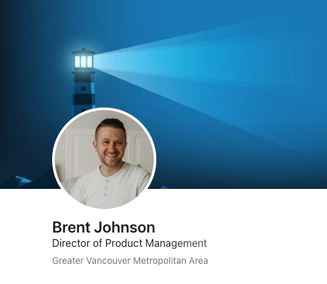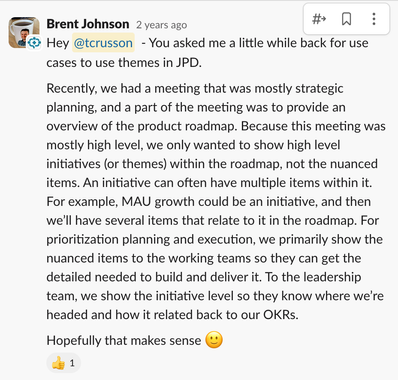Missed Team ’24? Catch up on announcements here.
×Community resources
Community resources
Community resources
How we built JPD with lighthouse users (Part 3 of 3)
In this third and last part of this article about working with lighthouse users, we will be focusing on what collaboration looks like with lighthouse users using a real example.
These are the very practices that have led Jira Product Discovery to be the fastest growing product at Atlassian.
Part 1 or the article is available here.
Part 2 is available here.
A real example of Jira Product Discovery lighthouse users
Meet Brent
Brent - who has since moved to Maple, a virtual care platform that allows Canadians to see a doctor online within minutes 24/7 - was in a context of collaborative prioritisation with leadership and sales, in a sales-led organisation.
 |
Why Brent? Alignment with vision: Brent sees prioritisation first and foremost as a collaborative process, involving the team and stakeholders including the C-suite. He keeps trying better ways to try and make this work. |
Opportunities
- More collaborative ways to run prioritisation sessions with the business.
- Brent is experimenting with ways to gather feedback from internal teams.
He has tried Jira Product Discovery for that, but now using Jira Service Management - no perfect solution yet.
The full extent of the value a lighthouse user brings to your product development process does not happen overnight. The richness of insights that lighthouse users bring to the team grows proportionally to the quality of your rapport.
Over time, they become more vulnerable and share what really bothers them in a particular situation. After a while, there are no more filters and that’s where as a team, you’ll get real authentic feedback.
Collaborating with lighthouse users across Wonder & Explore
You need lighthouse users on speed dial
This is critical to unlock decision-making at pace.
The easiest way to do this and maintain momentum is to share a common Slack workspace (or other instant messaging/collaboration) with your lighthouse users. This means that within the same day, you can share something with them and get feedback that allows you to move forward.
Here is an example of interactions we’ve had with our lighthouse users.
Example of off-the-cuff feedback from Brent
Example of outputs across Wonder and Explore
Below is an example of how our cohort of lighthouse users has informed the JPD product journey.
They have enabled us in better understanding the space we were operating in and who we wanted to solve for (left) and as a consequence, it allowed us to experiment with solutions that could address their problems in a pragmatic way (right).
|
Learnings from early conversations (Wonder) |
 Early mockup of JPD (Explore) Early mockup of JPD (Explore) |
Many breakthroughs we experienced on the journey building the first versions of JPD were thanks to our lighthouse users and our close collaboration.
Your collaboration style with lighthouse users will change as the product matures
As we move into Make, the collaboration style with lighthouse users organically evolves towards something less frequent and more focused on specific aspects of the solution.
However, still now — at Scale — these same lighthouse users play a very special role in our product journey.
When we are faced with uncertainties around some foundational aspects of the problem we’re trying to solve, we typically go back to our lighthouse users for additional input and feedback. They basically keep us in check.
When to stop collaborating with lighthouse users?
The short answer is of course…”it depends”.
As your product evolves, it is OK to look for lighthouse users other than the initial cohort. You might want to look for people who are better aligned with the struggles of the current state of the product.
As we want to unpack new areas in the JPD team, e.g. working with larger customers, we will typically look for lighthouse users who align with that new space.
Key takeaways
- Lighthouse users allow you to execute 10x faster
- Getting to lighthouse users takes time and it’s OK if it doesn’t work out straight away.
- 10 lighthouse users are enough to get you to a product that solves their main challenges.
- Get your whole team in front of lighthouse users regularly. Their day-to-day decisions will be infused with customer knowledge.
- Create a space for effective collaboration with your lighthouse users so it feels like you have them on speed dial.
- Ask yourself whether your are getting value from the collaboration with lighthouse users at each stage of the product development. If not, it might mean it’s time to renew lighthouse users.
If you've enjoyed this article, please let us know by liking 👍 this post.
👋🏽 We need your help
If you are a Product Operations Manager and want to be part of our ongoing customer discovery program about product management best practices, I'd love to hear from you.
Please connect with me on LinkedIn here.
👁️ Watch this space if you want to learn more about how we do product in the JPD team.
Was this helpful?
Thanks!
Axel Sooriah

About this author
Product Management Evangelist
Atlassian
France
Atlassian Community Events
- FAQ
- Community Guidelines
- About
- Privacy policy
- Notice at Collection
- Terms of use
- © 2024 Atlassian







0 comments